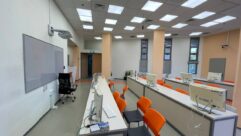Mapping the Future of LCD TechnologyPixel mapping helps LCD projectors and LCLVs overcome many of their fundamental limitations and significantly improves their versatility.
May 20, 1996 12:00 PM,
Steven Barlow
Since appearing in the commercial market during the late 1980s, LCD (liquid crystal display) projectors’ image quality and popularity have soared. Today, LCD projection technology spans a range of products, from low-end portable units designed for video or simple laptop presentations to powerful and sophisticated LCD light-valves (LCLV), which can create brilliant, large-screen images from virtually any video or RGB computer source.
Video contractors have found that this new breed of projector offers higher light output, significantly easier setup and less maintenance than CRT-based projection systems. As a result, LCD projectors are being used in an increasingly larger array of new applications. However, LCD projectors have some fundamental limitations based on the fixed nature of their pixels: The pixels on the LCD panel must match the pixels from the source, a limitation that has prevented LCD projectors from being used in some applications.
The solution to the problem is pixel map processors (PMPs), which help overcome these limitations and improve versatility. To understand how these sophisticated circuits work, let’s take a look at LCD technology itself.
Projection technologiesA number of different LCD projection technologies are on the market today. By far the most popular is the active-matrix liquid-crystal display (AMLCD). (See Figure 1.) The most common configuration of the AMLCD projector is similar to an ordinary slide projector whereby the projector comprises a light source (a lamp), a slide (the LCD panels) and a single projection lens. Some units use a single LCD panel with color filters to create a full-color image. Other AMLCD projectors use three LCD panels and dichroic optics to create high-contrast color images with excellent color purity. In either case, the LCD panels act as an electronic slide modulating the light from the projection lamp to create a full-color picture. (See Figure 2.) Thanks to their single-lens design, the LCD projectors are easy to set up.
LCLVs are different from low-end projectors because they sacrifice size and portability in favor of better image quality and sheer light output. LCLVs use a powerful metal-halide or xenon arc lamp to generate on-screen images up to 20 times brighter than three-gun CRT projectors. For the large screens of 10 feet (3 m) and larger used in mass audience presentations, such as concerts, trade show exhibits and rental situations, light-valves are the only projectors capable of providing adequate brightness. Light-valves are also effective in environments with high ambient light.
The primary advantages of single-lens LCD projectors are high light output and ease of use. The disadvantage is restricted input flexibility. To emulate the versatility of CRT-based systems while offering the intrinsic advantages of LCD projection, these devices must overcome some fundamental limitations.
Overcoming obstaclesUnlike CRT projectors, LCD projectors are notoriously inflexible as to their input signals. These units are based on an LCD panel with a fixed matrix of pixels. For example, most units on the market today can display only video signals and RGB signals from a VGA or Macintosh computer with a resolution of 640×480 pixels. These projectors use LCD panels with a matrix of rows and columns with 480 rows of pixels on each row. In total, 640×480 or 307,200 pixels are available to create an image.
This works out great if your source is NTSC video or a standard VGA or Macintosh computer because one pixel on the LCD panel corresponds directly to each pixel from the source. But if you’re a user who wants to display a big, bright presentation of XGA graphics at 1,024×768 or 786,432 total pixels, with most LCD projectors you’re out of luck.
Because LCD projectors use a fixed matrix of pixels, they must rely on sophisticated electronic circuits to map each pixel of the projector’s input signal to each pixel of the LCD panels. These circuits are called the pixel map processor (PMP), sometimes referred to as a scan converter. All AMLCD projectors require some sort of PMP to convert the analog signal from the input source into a digital format compatible with the fixed matrix structure of the LCD panels. What the PMP does is take the incoming analog signal and digitally manipulate it into an addressable format compatible with the individual pixels on the LCDs. This process is called pixel mapping and is a core technology of all AMLCD projectors. (See Figure 3.) When LCD projectors fail to display an image from the source computer properly, chances are it’s due to the limited processing power of the projector’s PMP.
Low-end LCD projectors offer basic scan converters that can accommodate NTSC video. In addition to video inputs, some LCD projectors can also accommodate VGA or Macintosh computer sources for data display applications. However, because the resolution of the LCD panels is fixed, usually at 640×480 pixels, the projected image will not be able to go above this threshold. Because most low-end LCD projectors have very limited pixel-mapping capabilities, they simply cannot display a usable picture when connecting a Super-VGA input signal of 800×600 (480,000) pixels or higher. This problem with input flexibility severely limits the practical use of most LCD projectors.
One solution is to use a stand-alone scan converter. This can help increase source compatibility by converting the input signal resolution to match the fixed resolution of the projector’s LCD panels. However, these devices sell for $5,000 to $20,000, making them quite an expensive peripheral. In addition, other aspects of their performance are not well-adapted for projection applications.
To address this dilemma, a new generation of LCD projectors and LCLVs feature a built-in scan converter to achieve broader input capability. These internal scan converters use high-speed graphical processors and ultra-fast memory chips to maximize performance. Because they are customized for the LCD panels used in the projector, they are able to map each pixel of the input source exactly to each corresponding pixel of the projector’s LCD panels. The result is a greatly expanded range of input signals that can be faithfully displayed on the large screen.
Timing is everythingUnlike their CRT-based cousins, which are dependent on horizontal and vertical synchronization signals (scan frequencies) to create an appropriate image, LCD-based projectors must digitally sample their analog input signal and then convert it to a precisely timed stream of pixels to produce an image. This conversion process is the essence of pixel mapping. Sampling is an important part of the pixel mapping process because it is crucial in determining the accuracy and stability of the projector picture.
To sample the input signal properly, the projector’s sampling rate must be faster than the input signal’s rate, otherwise some picture elements could be lost. It’s a general rule that the sampling rate should be at least four times faster than the highest frequency component of the input signal. Hence the term “four-times oversampling” is often associated with digital music devices such as CDs.
Because of the extremely high data rates in RGB computer signals (greater than 100 MHz), oversampling can be difficult to achieve. In this case, the PMP must use synchronous sampling, whereby the timing of the PMP’s sampling clock precisely matches the input signal’s pixel (dot) clock. Synchronous sampling is more critical because it requires the input signal sync pulses and internal processing circuits to have ultra-high stability. Any variations in these areas can result in an unstable image on the screen.
To produce a full-color image on the screen, each pixel on the LCD panels has to be able to assume at least eight shades of gray per color. This ranges from fully open, a white pixel, to fully closed, a black pixel, or some value in between. The timing and converging of the aligned red, green and blue pixels in these gradations create the possibility of displaying up to 16 million colors. The projector’s PMP must have enough processing power to manage effectively the manipulation of each individual pixel for the red, green and blue images in real time.
Pixel mappingThe PMP is a crucial element of advanced LCD projectors and LCLVs, allowing them to overcome the inherently inflexible input capabilities of active matrix LCDs by emulating the flexible nature of today’s data and graphics CRT projectors. Ideally, the PMP must be able to accept any input signal and digitally map it to the full resolution of the projector’s LCD panels. Only a few projectors today are equipped with such sophisticated PMP technology, including Barco’s family of light cannon projectors (BarcoData 8100, 5100 and 3100 LC.)
The PMP for these projectors can increase or reduce the resolution to match best the projector’s three LCD panels. These processes are called “pixel interpolation” (increasing) and “pixel decimation” (reducing). (See Figure 4.) In addition, the pixel conversion may be turned off in order to achieve the conventional 1:1 mapping, whereby each pixel of the input signal is mapped directly to a corresponding pixel on the projector’s LCD panels. Let’s take a look at how this works.
Pixel interpolationIn the BarcoData 8100 LC, each LCD panel has a resolution of 768×556 pixels (420,336 pixels per color). If we turn off the pixel conversion (as in a conventional LCD projector), the projector will use 1:1 mapping. If a 640×480 VGA signal is sent to the projector, only 307,200 pixels are used, even though the panel has 420,336 available. As a result, just 73% of the LCD panel surface area is used. The outer 27% that frames the image is unused and remains dark. This scenario has three problems: The full resolution of the LCD panels is not being used, the projector’s total light output is reduced by 27%, and the picture is not as large as it might be.
All three of these problems can be solved by pixel interpolation. To achieve the full resolution of the panel and boost the light output to 100%, the image is electronically stretched to fill up the entire 756×556 area of the panel.
How does this happen? First, the projector’s PMP reads the input signal pixel-by-pixel and evaluates the nature of the image. Next, the PMP determines whether the picture is a still or moving image, then calculates, in real time, the correct value of new (interpolated) pixels adjacent to the original pixels. Finally, by carefully adding the 113,136 interpolated pixels to the input signal’s original 307,200 pixels, the PMP is able to create an image that fills the 420,336 pixels of the projector’s LCD panels. The result is a full-frame image that matches the resolution of the panels and makes maximum use of the projector’s light output.
Pixel decimationAnother problem can occur when the resolution of the input source exceeds that of the LCD panels. Say you wanted to project a high-resolution presentation from your PC with an XGA graphics board that has a resolution of 1,024×768 pixels (786,432 total pixels). If a conventional 640×480 LCD projector with 1:1 mapping were used, the most you could hope for is to see 307,200 pixels out of the total 786,432, which is less than 40% of XGA resolution; more than 60% of your data would be lost. Using a projector like the BarcoData 8100 LC, the image can be electronically compressed to fit the full resolution of the LCD panels.
How? Once again, the projector’s PMP comes into play. After sampling and analyzing the picture content, the PMP selectively deletes (decimates) pixels it determines are not absolutely necessary to construct the image. Only the essential pixels remain. The net result is a projected image remarkably faithful to the original despite the fact that it uses only 53% of the original pixels. Although this example may illustrate a compromise, most LCD projectors would not be able to show an entire XGA image or any image at all.
Advanced capabilitiesIn instances where the PMP is performing pixel decimation, it is useful to pan across and zoom into the image area. These possibilities allow the user to highlight and magnify areas of the projected images that might be important to the presentation. High-performance PMPs also allow for geometric corrections such as image size, image shift and electronic keystone correction. These advanced functions successfully emulate the versatility found in CRT-based projectors and are achieved through the adaptive PMP found in Barco’s family of light cannon projectors. When used with a special anamorphic lens, these advanced functions make it possible to display 16:9 HDTV images with the BarcoData 8100 LC even though it uses LCD panels with a 4:3 aspect ratio.
Looking forwardThe development of advanced PMPs has helped LCD projectors and LCLVs to overcome many of their fundamental limitations and has significantly improved the projector’s versatility. When considering these improvements together with their reputation for very high brightness, ease of use and good reliability, today’s new generation of LCD projectors and LCD light-valves offer performance and flexibility that will make them the ideal solution for a wide range of applications.
In the future, the development of faster and more powerful PMPs will run in parallel with the introduction of new, higher resolution LCD panels. Future LCD projectors will offer higher light output thanks to recent advances in LCD technology and breakthroughs in new illumination systems. Together, these advancements will provide us with the best of all worlds: high light output, exceptional resolution, ease of use and total versatility. Who could ask for more?










